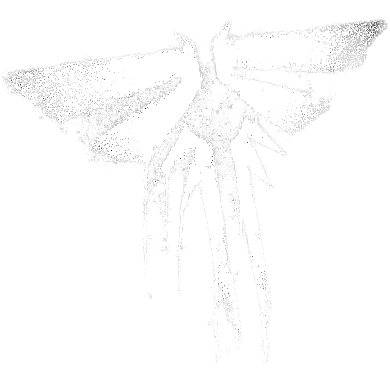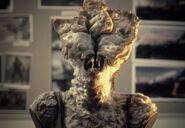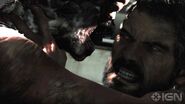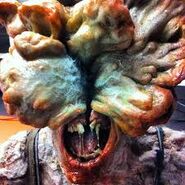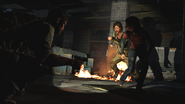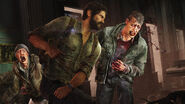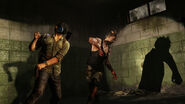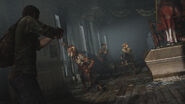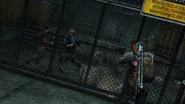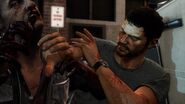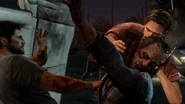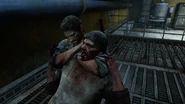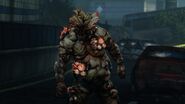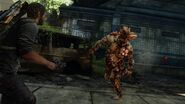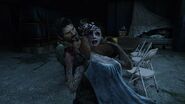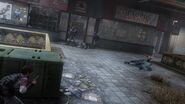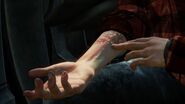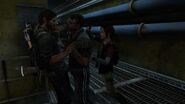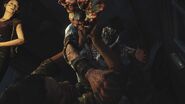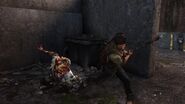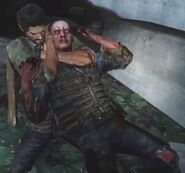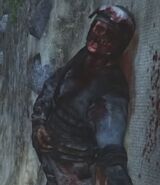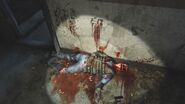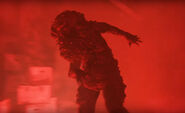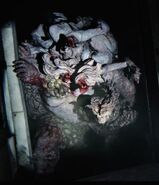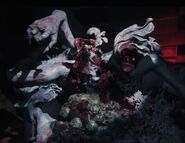m (→Strategy: Proofreading) |
(The Stalkers will die attached to the walls. Infected at any stage can die from natural causes, the later stages only happen if certain environmental factors are met (and you can more easily determine just how old they are).) Tag: Visual edit |
||
| Line 66: | Line 66: | ||
Stalkers are rather rare and are only encountered as the main enemy twice in ''The Last of Us'': once in the basement of [[The Hotel Grand|the hotel]] in [[Pittsburgh]] with a Bloater and once in the Sewers with a pair of Clickers. They are also encountered in the ''[[The Last of Us: Left Behind|Left Behind DLC]]'' by Ellie for the first time on their own. Strangely, all of these places are either flooded or located near water; Stalkers often use this to their advantage, ambushing the player when they get close. |
Stalkers are rather rare and are only encountered as the main enemy twice in ''The Last of Us'': once in the basement of [[The Hotel Grand|the hotel]] in [[Pittsburgh]] with a Bloater and once in the Sewers with a pair of Clickers. They are also encountered in the ''[[The Last of Us: Left Behind|Left Behind DLC]]'' by Ellie for the first time on their own. Strangely, all of these places are either flooded or located near water; Stalkers often use this to their advantage, ambushing the player when they get close. |
||
| − | In ''[[The Last of Us Part II|Part II]]'', Stalkers behave differently and appear frequently in [[Seattle]]. They are typically found in abandoned, poorly lit buildings and parking lots, though they also appear in the sewers and subways areas. They are also prominent in the forest areas of the city, especially in Seraphite-controlled territory. Stalkers are difficult to see in Listen Mode, when approached they will immediately run away and will only become aggressive when they are provoked by a loud sound-inducing attack such as a gunshot or explosion. When encountered in groups, they will hide and attack their prey in a co-ordinated manner. Inside buildings, |
+ | In ''[[The Last of Us Part II|Part II]]'', Stalkers behave differently and appear frequently in [[Seattle]]. They are typically found in abandoned, poorly lit buildings and parking lots, though they also appear in the sewers and subways areas. They are also prominent in the forest areas of the city, especially in Seraphite-controlled territory. Stalkers are difficult to see in Listen Mode, when approached they will immediately run away and will only become aggressive when they are provoked by a loud sound-inducing attack such as a gunshot or explosion. When encountered in groups, they will hide and attack their prey in a co-ordinated manner. Inside buildings, certain Stalkers have become attached to walls, with fungus gradually growing out of them. Over the course of potentially decades, they will eventually die and calcify. However, if found by survivors, they will break free and attack them. |
There is a rare, unique Stalker variant encountered in the hospital basement which pulls itself free from a Rat King. This variant is stealthy and nimble like a Stalker but boasts increased durability and the throwable acid pods of a Bloater. |
There is a rare, unique Stalker variant encountered in the hospital basement which pulls itself free from a Rat King. This variant is stealthy and nimble like a Stalker but boasts increased durability and the throwable acid pods of a Bloater. |
||
Revision as of 15:52, 7 July 2020
| “ | ” |
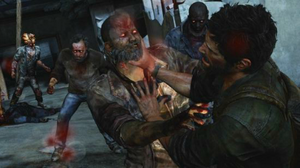
Several common varieties of Infected.
The Infected are humans who have been infected and subsequently mutated into horrific new forms by the Cordyceps Brain Infection. The resulting creatures are aggressive, and will attack any uninfected human on sight.
The Infected are one of the main enemy types in The Last of Us, Left Behind, and The Last of Us Part II, the other being the human enemies.
Overview
The Infected are the result of a sudden outbreak of a mutant Cordyceps fungus that now affects human beings as opposed to insects. The fungus reportedly originated in South American crops; various newspapers in the prologue support this claim. The fungus infects the human brain, growing mycelium inside the brain tissue and killing the brain's cells. This erases their memories and drives them insane, modifying their instincts to seek no goal other than spreading the spores to others. Eventually the fungus kills its host, and will then grow out of the host's body to spread spores.
Public reaction to the Infected has been catastrophic. As the vicious fungus has taken hold of the majority of the population, the worldwide pandemic causes the total breakdown and destruction of society through widespread violence; the failure of martial law to contain the outbreak, the military's increasingly violent efforts to censor information, and the near-extinction of humankind. The Fireflies – a militia group formed in response to military oppression – have conducted a mostly futile war against the barely-functional government. They believe they can create a vaccine through study of the fungus and its hosts, one of the last organizations to do so.
Those who are clear of infection are ordered by martial law to reside within a Quarantine Zone. The military at one point bombed areas outside the Quarantine Zones to kill the infected and execute anyone suspected of infection on sight.
Biology
Infection
| “ | [...] the antigenic titers of the patient's Cordyceps remain high in both the serum and the cerebrospinal fluid. Blood cultures taken from the patient rapidly grow Cordyceps in fungal-media in the lab...
―Surgeon's recording
|
” |
For humans that have been exposed to a mutated strain of Ophiocordyceps Unilateralis, the fungus attacks the brain and begins to alter the behavior of its host. The host will then go through four different stages of infection: Runner, Stalker, Clicker, and Bloater or Shambler; each stage is more dangerous than the last. However some have had resistance to the infection, notably Ellie; she hasn't turned despite being infected for over five years.
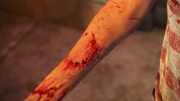
Infection can be spread through biting a victim.
The infection also spreads directly through contact with an Infected or via their corpse - that is, the infectious spores created by the Cordyceps and released from the host's body upon death. These spores can quickly infect an individual, making breathing difficult and movement sluggish within only minutes is exposure in such spore dense areas. Only Ellie has exhibited the ability to breathe spores without difficulty.
Spore development is the last stage in the life cycle of the Infected. This lifeless carcass serves as a breeding ground for the fungus to spread throughout the environment. When near death, an Infected will find dark, moist corners to die in. While this may be the end for the host, the fungus continues to grow. The Last of Us game team has stated<option>*…{{{1}}}</option> that the people in the Quarantine Zones are relatively safe because they are in places with significant airflow, leading to a low spore concentration, explaining why the only places with significant spore toxicity tend to be underground or abandoned buildings.
In order for the fungus to infect a host body, the host must first be alive. Dead victims who come into contact with the infection do not undergo transformation. According to a pamphlet released by the Center for Disease Control, the victim can only become infected by inhaling the spores directly or coming into contact with an Infected's bodily fluids, usually from a bite.
Infected individuals must be exposed to specific conditions and circumstances in order to progress to the next stage of infection, otherwise, they may stay at one stage for an extended period of time. This is presented in the large number of Runners in Bill's Town and in Jackson.
Due to growing a fungus within themselves, all of the infected are vulnerable to fire. However, the Rat King stage is immense in spores that it can survive extensive exposure to fire, able to charge through flames with only minor stagnation.
Physical appearance
The Infected humans have since undergone a strange mutation by a specialized strain of cordyceps. Runners seemingly begin to experience hair loss, discolored skin accompanied with lesions, and bloodshot eyes. Stalkers can be seen with significant fungal growth around their eyes and shoulders. Clickers are horrifically mutated by the infection. By this stage, the skull has been split open due to advanced fungal growth on the brain, growing over or outright destroying the host's eyes. Their teeth are rotten and jagged, and their skin is covered in mold. The fungal growth on Bloaters is so advanced that it begins to form armored plates on the host, while also causing the body to bloat significantly. The fungus also seems to offer the host some protection against the elements, such as the cold. When the host is killed or dies from advanced fungal growth, the fungus continues to grow throughout the body, eventually emitting spores.
Behavior
| “ | You know, as bad as those things are, at least they're predictable. It's the normal people that scare me.
―Bill
|
” |
Upon becoming Infected, the victims gradually lose any ability to think freely and begin to behave irrationally as the fungus spreads in the brain. Relying on warped instincts, the Infected will attempt to attack and/or eat any human they find. This becomes most prominent at stages 3 and 4, when their human characteristics begin to cease to exist entirely (e.g. feelings, thoughts, etc.). They lapse into their primitive, animalistic instincts, attacking anyone or anything that disturbs them, almost as a way to protect their territory. However, Clickers can be seen twitching and sometimes clawing at the fungal growth covering their face, suggesting that there still may be vestigial elements of the host attempting to resist the infection. According to the Head Surgeon, fungal-growth in the limbic regions normally accompanies the prodrome of aggression in infected patients.[1]
The fungus spreads to the host's eyes as it grows, covering and blinding them. They then develop a primitive form of echolocation to locate prey, which results in them making a distinctive clicking sound. After some time, the fungus kills the damaged host, usually in a closed-off space so the fungus can spread further.
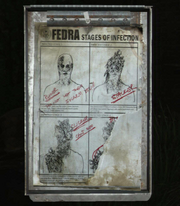
A Military Pamphlet that outlines the stages of infection
The Infected, while having a higher pain tolerance than ordinary humans, are still susceptible to conventional injuries. A Runner, when not attacking survivors, will moan in pain due to the fungal growth deforming its body and Clickers will struggle while being shivved. Sometimes Infected that still have their entire face intact look sad or worried as they attack, indicating that first and second stage Infected are aware of what they are doing, but cannot control themselves. Gunshots are capable of startling Runners and Stalkers, so they seemingly feel fear in the early stages of infection. All stages of infected will flail and scream wildly when set on fire or severely wounded. The body of an infected will spasm violently when the host is killed. The Infected have also developed sensitive hearing, as they can hear sounds that normal survivors cannot, such as the player hurdling nearby obstacles.
Stages of infection
Runners
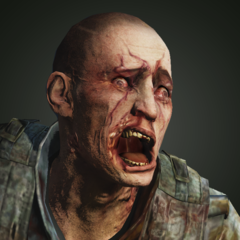
A Runner
Runners are the first and weakest stage of the Infected who have just recently entered their transformation. People who have been infected will enter this stage within 1-2 days with increased irritability and hostility towards others being a key symptom. Since the eyes are first targeted by the fungus, Runners have poor eyesight, but maintain some human characteristics. For example, their moans are still human, just like their overall appearance. A way to tell them apart from normal survivors is their glowing orange eyes. They also stay in a hunched position when motionless or when moving around passively, unlike normal survivors. Their body language is sluggish while they are passive, suggesting they are resisting the fungus's influence, albeit usually in vain. Some survivors believe that the infected person's mind is still intact, but trapped in their on body, as shown by a crying Runner that was upset at attacking her friends. Sometimes they do not attack at all, even when non-infected individuals are right in front of them. These non-aggressive Runners will only attack if attacked first or when an object is thrown at or near them, thus losing control. They will also become aggressive if a non-infected individual is extremely close in front of them. Much like sneezing, the urge to attack after such interactions happens involuntarily and unwillingly by the host. Runners are confirmed to be able to attack in packs, flailing their arms in attempts to trample the survivor.[2]
Like survivors, they can be strangled when grabbed from behind.
Runners seem to have an easier time than humans when it comes to spotting Joel and Ellie as, with humans, Joel can just walk up behind them and strangle them; something that is not possible to do with Runners without them spotting Joel. Also, moving Runners seem to be capable of spotting Joel when crouch-walking, indicating heightened awareness. The Runners can also grab Joel and will try to bite and infect him while doing so, but they are less likely to be successful due to the fact they can be shaken off, unlike the physically enhanced Clickers.
Runners return in Part II, and are stronger than they were in the first game.[3] In addition, their appearances have changed as their skin is more pale and their eyes are now more bloodshot.
Strategy
Anything works against Runners, and generally, the main concern when fighting them is the possibility of being swarmed by them in large numbers, in which case, one may consider attempting to escape their detection by sprinting away to a distance and diving behind cover. Stealth is a good option while dealing with them, although not entirely necessary. As with any other choke-able enemies, the player needs to be careful about being spotted by other nearby enemies while choking them out one by one. Attempting to strangle Runners from the front will cause them to become aggressive and alert nearby Infected, so it's advised to avoid such. Individual Runners are also easy to melee even with bare fists, so using up any ammunition when fighting them can be wasteful when there are only a few of them. There is little gained, but plenty lost if Joel uses a shiv on them, as shivs are best saved for Clickers, shiv doors, and Stalkers to obtain the The Hunter Becomes the Hunted trophy.
The Runners are at such a weak stage that most survivors can easily defeat them with little trouble, such as the Cannibals at the Colorado Mountain Plaza; they could easily out brawl them in melee combat and could flip them over their heads and stomp them.[4] Others however, like the average Smugglers, seem to struggle, being overwhelmed by them in seconds. [5] However, the well-equipped Washington Liberation Front soldiers fared well against the Runners in the subway station in Seattle[6]
Also, Runners are extremely dangerous around Clickers and Bloaters as the former are still able to see survivors, alerting the latter to their presence. It is best to strangle any Runners in the vicinity, as this will maintain the quiet ambiance needed to bypass Clickers and Bloaters.
Stalkers
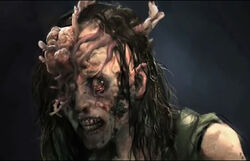
A Stalker
Stalkers are the second stage of the infection. They have the vision and speed of Runners, with the ferocity of Clickers. The most notable physical traits that define the Stalkers are the distinct croaking noises they make, the beginning of fungal growths on the head and face with only one eye left, the development of pseudo-echolocation, and their discretion upon spotting a victim at a distance. They will strafe and take cover, eventually closing in on the victim, hence the name "Stalker". Up close, Stalkers are very aggressive and will charge directly at the victim. Stage 2 may take place anywhere between a week to a month after the start of the infection (Stage 1) and last up to a year (Stage 3).[7]
Their strength is equal to a fit human being, as their attacks can interrupt actions made by the player. Although their grab attack can be shaken off, it will still result in an instant death from blood loss/infection if the Stalker succeeds with the attack.
According to the Stages of Infection collectible, the modus operandi of a Stalker is to "hide and ambush victims." The collectible implores readers to check their surroundings, but no other information is provided.[8] Their croaking may be heard from a distance in various areas, but it only serves as ambiance rather than a threat.
Stalkers are rather rare and are only encountered as the main enemy twice in The Last of Us: once in the basement of the hotel in Pittsburgh with a Bloater and once in the Sewers with a pair of Clickers. They are also encountered in the Left Behind DLC by Ellie for the first time on their own. Strangely, all of these places are either flooded or located near water; Stalkers often use this to their advantage, ambushing the player when they get close.
In Part II, Stalkers behave differently and appear frequently in Seattle. They are typically found in abandoned, poorly lit buildings and parking lots, though they also appear in the sewers and subways areas. They are also prominent in the forest areas of the city, especially in Seraphite-controlled territory. Stalkers are difficult to see in Listen Mode, when approached they will immediately run away and will only become aggressive when they are provoked by a loud sound-inducing attack such as a gunshot or explosion. When encountered in groups, they will hide and attack their prey in a co-ordinated manner. Inside buildings, certain Stalkers have become attached to walls, with fungus gradually growing out of them. Over the course of potentially decades, they will eventually die and calcify. However, if found by survivors, they will break free and attack them.
There is a rare, unique Stalker variant encountered in the hospital basement which pulls itself free from a Rat King. This variant is stealthy and nimble like a Stalker but boasts increased durability and the throwable acid pods of a Bloater.
Strategy
Some Stalkers have a bioluminescent vein in the face which makes them easier to see in the dark. They are fast and deadly in combat, especially when confronted in numbers. Because of this, it is best for Joel to keep his distance when trying to confront a group of Stalkers. The player may lure nearby Stalkers and then use explosives as they approach Joel.
Stealth is an option, but not advised due to them being almost impossible to grab while moving because of their heightened awareness. They may also run away to take cover if they see the player approaching from a distance. There is a tag worth 100 in-game currency called The Hunter Becomes the Hunted for stealth killing a Stalker from behind for the first time though this is not advised when there is a group of them because there is a high chance they will overwhelm the player.
Because they are stronger than Runners, Stalkers can override Joel's punches by grappling or striking him. One way to combat this is to throw a brick or bottle at them then attack, or simply use a melee weapon rather than fight barehanded. However, because they are often encountered in large numbers, it is best to rely on ones armed fire. One blast from a shotgun is enough to take them down, as is a headshot from the hunting rifle.
Unlike the more able bodied Joel, it is challenging for Ellie to combat them, as she only has her pistol when facing them. Because of this, it is best for Ellie to rely on bricks in the area, throwing them directly at the Stalkers to stun them so she can stab them with her switchblade. In Part II however, the adult Ellie is able to outwrestle them in close-quarters combat and can swiftly dodge their surprise attacks.
As a step up in strength from Runners, Stalkers proved difficult foes for people to defeat. Many groups of soldiers and WLF grunts have been killed by Stalkers, particularly those that are forced to fight them in enclosed buildings where lighting is minimal and there are plenty of spaces for them to hide.
Clickers

A Clicker
Clickers are the third stage of the Infected and take roughly a year to reach this stage of infection.[7] They have had prolonged exposure to the fungus, and now possess strength that significantly surpasses the average human. This makes them deadlier, but at the price of being completely blind due to fungal infection taking over their face. However, Clickers are able to maneuver through areas by utilizing echolocation, which produces noticeable clicking/screeching noises to locate sources of sound, hence their name. Like Runners, Clickers can sometimes be found in a passive state.
Clickers appear less human than Runners and Stalkers, with faces that are completely skewed and scarred by fungus developed from their infected brains. The fungal plates have apparently adapted to keep the host/pathogen alive and able to spread, as a direct shot to the face with a powerful weapon such as a revolver will more often than not just break off a chunk of the mold, leaving the Clicker's brain unharmed but exposing the victim's face and rendering them able to see once again (until the fungus regrows). Clickers are dangerous and much more aggressive than Runners, and like Stalkers, they no longer resist the fungus because their humanity has been completely eliminated. They seem to have enhanced strength, as they can overwhelm and kill Joel if grappled and always succeed if attacking other humans, like the group at the mountain plaza. Clickers also possess what seems like very high intelligence, never leaving an area when they have heard prey run by them, and will constantly check every available nook and cranny to locate the source of the sound with little regard to give up on the task at hand.
When provoked, a Clicker will immediately enter into a "berserk mode," aggressively flailing its arms and 'roaring'. At this point, if a survivor has been "spotted" by a Clicker, the Clicker will attack head-on and will not flinch when shot, unless the player is using high-powered rounds.
Strategy
Punching a Clicker with bare hands is ineffective — after three punches, Joel will not have time to back away and will be instantly grappled by the Clicker, especially if the Clicker is in berserk mode, where it overrides Joel's punch. It is recommended that players use a melee weapon if they choose this form of attack. If not, the ideal weapons to use are the shotgun, El Diablo and the flamethrower because they, when used effectively, guarantee kill.
In The Last of Us, f Joel is grappled by a Clicker, he can save his life if he has a shiv and at least level 1 of the Shiv Master skill, unless the player is playing on easy mode, where they already have the skill. If not, Clickers will bite Joel, resulting in a game over. It is possible to avoid or distract Clickers instead of fighting them directly by throwing bottles or bricks.
When the Clicker does manage to go into berserk mode, it is advised to keep one's distance before aiming at it or trying to hit it to avoid being grappled.
If the player desires to engage them stealthily, Clickers can be killed by either using a shiv or the bow and arrow. However, using an arrow to kill a Clicker requires a headshot - which has an 80% chance<option>*…{{{1}}}</option> of breaking the arrow - or two chest shots, which will alert them, so unless done fast enough, the player will be detected. This is risky, however, as the fungus around their face acts as a sort of armor, which significantly increases the chance of the arrows breaking. Shivs are also needed to unlock Shiv Doors, which contain special items that are needed if one wants to have the best chance of surviving. However, due to Clickers being blind, the player can safely shiv them from the front, provided they are in their passive state. Clickers that are active can only be shivved safely while the player is behind them, although having Shiv Expert unlocked allows a player to shiv them if grappled.
In Left Behind, Ellie can easily dispatch unaware Clickers from the front with her Switchblade by standing still and waiting for them to walk toward her. This also works if they are investigating the sound of a thrown Bottle.
It is easy to outrun a Clicker, as their crude echolocation has a short range and, unlike Runners or Stalkers, they move at a moderate pace. The Cannibals realized this, avoiding guaranteed defeat in close combat and attacking with firearms from a distance, where they were safer. [4] When far enough away or behind cover, the Clicker will get confused and click in all directions. This makes them easy to avoid as the player simply has to crouch behind cover. The echolocation only ranges a few feet, unless the player fires a gun.
If stunned with a brick first, players can kill Clickers with melee attacks. If done successfully, the player can sprint towards them and finish them off with a running melee strike (a running punch combo can also work, but is more risky), This method could be attempted approaching the Clicker from the front, though the back is usually the safer option. They can also kill a Clicker with just a 3-hit combo from the brick, but can be dangerous if done when the Clicker is in berserk mode.
Clickers are extremely susceptible to Molotov Cocktails and groups of Clickers can be taken down by them. When encountering multiple Clickers, simply throw a Molotov into the middle of the area. Upon hearing the sound of the bottle breaking, all Clickers will bee-line for the noise and, in the process, walk right into the flames, burning themselves to death.
In Part II, the player is able to push Clickers if they get close and have more melee weapons to hit them with It is still advised to upgrade the melee weapons to have piercing effects for more effective damage in combat.
Bloaters
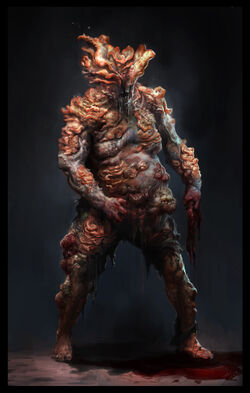
A Bloater
Bloaters are the fourth, rarest, and most dangerous stage of infection as they take the longest to develop, taking years to reach this stage.[9] They are covered in thick fungus that effectively acts as armor. Because of this protective covering, they can withstand multiple hits from weapons such as the Shotgun and Hunting Rifle, and even hatchets and machetes making them extremely tough to eliminate. Bloaters are extremely aggressive, but are rather slow-moving, making them more predictable than other infected. Like Clickers, Bloaters 'see' using echolocation to locate and trap a survivor. Because the fungus has completely deformed their face and blinded them, their echolocation is a lot less refined than the Clickers. If a Bloater grabs a survivor, it will violently rip their jaw apart through brute strength, grab the player's head and smash it, pin them to the ground and pummel their body mercilessly, or grab the survivor's neck and bend it to break the spine, killing them instantly. There is no way for the player to defend themselves if grabbed - the result is an instant kill. Bloaters throw sacks of mycotoxin, which explode on impact, spraying the target with the toxin. The mycotoxin will hurt the player over time, so it is recommended to avoid these deadly clouds.
Bloaters, like all Infected, are vulnerable to fire. When set ablaze, a Bloater will wildly thrash around, trying to put out the flames. After being immolated, they will be charred, black, and smoking. Their armor will also be charred and brittle, making them vulnerable to low-powered weapons. Despite this weakness, fire-based weapons such as Flamethrowers or Molotov cocktails still require multiple uses before killing a Bloater. Their other, less effective, weakness is armor piercing rounds from an upgraded weapon, like the Hunting Rifle. It will take fewer shots to kill if the weapon has the Power and Armor-piercing upgrades. Considering the rate at which Cordyceps grows after its fruiting body has emerged from the hosts head, the infected is estimated to take from 10 to 15 years to reach stage 4<option>*…{{{1}}}</option>.
Furthermore, despite their tough fungal armor, they are not immune to melee weapons as long as enough force is exerted on them. Joel was one of the few people to demonstrate this, as he was able to slash a Bloater to death while also amputating its arm with two hits from a machete.
Bloaters are found in the five following locations in The Last of Us:
- One in the gym of the High School in Lincoln. (Must be fought)[10]
- One in the basement of The Hotel Grand in Pittsburgh (Can be avoided, not there on easy mode)[11]
- One in the dormitories in the University of Eastern Colorado. (Can be avoided; drops a Firefly Pendant if killed)[12]
- One in the mill during winter at the Lakeside Resort. (Must be fought)[13]
- Three in the underground tunnel in Salt Lake City. (Can be avoided)[14]
Bloaters are also found in the following locations in The Last of Us: Part II:
- One in the hotel outside of Jackson that Ellie and Joel face together. (Must be fought with and killed by Joel)[15]
- One in the W&B Arcade after Ellie falls through the floor. (Must be fought)[16]
- One in the hotel after descending many floors with Abby and Lev (Can be avoided)[17]
Strategy
The most efficient way to kill bloaters is to throw a Molotov Cocktail or use the Flamethrower on them, due to their vulnerability to fire. When they are stunned, use 2-3 rounds from a shotgun to kill the Bloater to save supplies and ammo. However, a burning and thrashing Bloater can still grab Joel and kill him, so under no circumstances should one ever let a Bloater get within melee range. To counter this, two shots from a fully upgraded El Diablo, or Hunting Rifle, are also enough to kill a Bloater.
Another efficient way to kill Bloaters is to throw a Molotov Cocktail, then use a nail bomb while they are on fire. Do not get too close, however, as it will always charge at the player.
The Bloater actually draws its Mycotoxin bombs from bright, deformed patches growing on its body. Each Bloater has three: one on its lower right abdomen, one on its upper left chest, and one on its upper right back. Shooting any of these growths destroys them and reduces the damage required to kill the Bloater. Destroying all three will completely disable the Bloater's ranged attack, limiting it to charging at the player. This significantly increases the player's options for dealing with the Bloater, as it can no longer harm the player from a distance and is easily lured into traps. If unable to destroy them, the Bloater will take a short amount of time to throw the sack of fungus; when they then raise their arms, run away from the direction the Bloater is throwing the sac.
When dealing with a Runner, Stalker or Clicker, if the player has access to a brick or empty bottle, as well as a blunt weapon, the player can stun the Infected by throwing the object at it, and then continue by running towards the Infected while swinging a melee weapon. This will result in an instant kill. However this is ineffective against a Bloater, as its hardened face is impervious to thrown bricks/bottles and standing still may invite it to lob a fungus bomb at the player or close in for the kill.
For the early game, when the player does not have the Flamethrower, they can use their shotgun. Running in different directions, stopping and then firing one shot is time consuming, but it will work after many shots. If they run out of ammo for the shotgun, they can quickly switch to the hunting rifle. This is also viable on the higher difficulties, as one is better off avoiding enemies altogether to conserve ammunition or when they have run out of Molotov Cocktails and Nail Bombs. Even though Bloaters move slowly, they can still charge when they know the player is near so it is advised to avoid becoming cornered when avoiding a Bloater's grapple; special awareness is key to avoid being trapped.
Shamblers
Shamblers are an alternate fourth stage[18] of the Infected that are introduced in The Last of Us Part II, encountered in Seattle and Santa Barbara. Shamblers look similar to Bloaters and share many of their traits, such as immense strength and durability. They are horrifying, walking pustule-clusters that spray gaseous acid when they get near the player and take massive damage before dying. The fungal growth is so immense that spores cover their entire body, leading to oversized heads and torsos with dozens of the puss spores around them. In addition to this, their mouths have been stuck gaping wide by the fungus, preventing them from being able to bite. However, the growth has not consumed their arms and their eyes are still partially visible. Once defeated, these festering threats explode with violent force, emitting enough spores that deal heavy damage to the player.[19]
Like all Infected, they suffer high damage from fire attacks. While resembling Bloaters in size and appearance, they appear to lack their immense strength, as Ellie and Abby able to wrestle them off of her if grabbed. Their movement is just as a sluggish though, with most survivors able to outrun them if attacked though they can climb up and over obstacles. They are also shown to be far more numerous than Bloaters, occasionally appearing in packs.
It is suggested that Shamblers were in the process of mutating into Bloaters, but heavy exposure to water from the constant rain in Seattle caused them to change into Shamblers instead.[18] However, they are encountered in areas away from water such as in the suburbs of the city and the forest areas.
Rat King
Introduced in Part II, this anomaly, dubbed the Rat King, is a super-organism composed of multiple Stalkers, Clickers, and a Bloater that have been connected together by the Cordyceps fungus. This gives the creature incredible strength and resilience, surpassing that of a Bloater, shown in how it could easily smash through and destroy much of the lower levels of the hospital, including an ambulance, and was capable of taking extensive damage before dying.
After taking enough damage, some of the intertwined Infected can break off from the larger mass. Once an Infected has detached, it can have traits shared traits with other types of Infected. For instance, one Infected which detached resembled a Stalker in behavior and appearance but was able to throw sacks of mycotoxin similar to Bloaters. It appears every single Infected connected to the mass are their own entity as opposed to the mass being a single one.
Given Nora's comments, it appears the Rat King is made up of some of the first people ever be infected by CBI in city of Seattle, meaning it developed into this state over twenty-five years of infection. It appears to have formed by being sealed in a room so full of spores that as the fungal growths bloomed and spread, the Infected were merged into each other. The Rat King found in the basement of the Seattle hospital (Abby Seattle Day 2: Ground Zero) is the only known case of conjoined Infected.
Death and corpse

A deceased infected releasing spores.
Even after an infected individual has died, the fungus will continue to grow; consuming the body's mass to form a fruiting body and releasing spores that infect any human that breathes them. Survivors use gas masks to prevent this.
The process of forming the fruiting body causes the corpse becomes skeletal and brittle, fusing the remains to surfaces as it continues to grow. As sufficient time passes, the fruiting body becomes a "moss" that can fill entire structures with deadly fungal growths the color of pasty human flesh. Both of the spores and the fruiting body die quickly when exposed to sunlight, limiting the danger they present.
Gallery
The Last of Us
Part II
Trivia
- Interestingly, in-game Clickers jog when chasing Joel or an AI. However, in the cinematics I need a car and Name's David, Clickers do sprint.
- Clickers also sprinted in the PGW trailer for The Last of Us Part II as well.
- Clickers can be observed clawing and scratching the fungal growth on their eyes as if trying to get rid of their blindness.
- In Dontnod Entertainment's video game Life Is Strange 2, the protagonist Sean Diaz jokingly makes Clicker noises to try to scare his brother Daniel, after pointing out that a mushroom tree looks like a Clicker.
- In Hypixel, one of the most popular Minecraft multiplayer server, there is a game known as "Infection" where an infected player has a pixelated skin almost resembling the Clicker.
- In Techland's video game Dying Light, there is an Easter egg in which a zombie with its head shaped like a Clicker comes out of an elevator. In addition, it will drop an item called "Clicker" when killed.
- In the cartoon The Amazing World of Gumball, the episode "The Parasite" features a Clicker when Gumball merges with Darwin in order to warn Anais. He also mentions that he takes the zombie's form from a video game.
- The Infected appear to rest standing up. They do not click or attack even when the player is directly in front of them, unless provoked, while resting.
- If the Bloaters in the Pittsburgh hotel basement and UEC dormitory kill Joel, they will actually knock the mask off of his face in a special death animation.
- When controlling Ellie, the Bloater death scene changes; the Bloater simply punches Ellie, killing her with its sheer strength.
- In-game materials, concept art, and the "Grounded" Making Of documentary all show that the fungus is able to rip through bone.
- The skin of Clickers visibly "chalks," or forms large patches of scale-like tissue that glow in the dark. The patches are seemingly an earlier stage of the fungal infection growing out of their hosts' bodies, before said growth engulfs the entire body as seen with the final Bloater stage of infection.
- Runners do not moan as much nor in the same way as in previous beta demos as if in horrific pain but remain silent for the most part. However, they will screech when startled.
- Despite Clickers using echolocation, their echolocation is very crude compared to creatures like bats, as they will not notice that something is alive or moving unless it is directly in front of them. This supports the assumption of the front being where the clicks are sounded, as their face plates are shaped like a megaphone, directing it straight ahead of them, but not all around.
- Clickers do not click the same way as in previous beta demos where it would sound more like constant tapping of the tongue. In the final game Clickers click by waves of croaking rather than constant tapping.
- Stalkers appear the least amount of times when compared with other types of Infected, with the player encountering them a mere three times in the entire franchise so far, twice in The Last of Us, and once in the Left Behind DLC.
- They will appear more frequently in Part II, in the form of "mini-boss battles".[3] This is possibly because a Stalker's echolocation works best in enclosed areas.
- Even though objects can be thrown to distract the Infected, it should be noted that a major drawback to doing so is that it will draw them out of their scripted paths and allow them to freely roam the area, making it more difficult to predict their positions. If necessary, it is advised to have a steady flow of items to throw to keep them in the same area.
- Some of the concept art in The Art of The Last of Us shows Runners wielding tools such as shovels, knives, and rakes as weapons.
- Early concept art for the Infected showed them with an almost alien appearance, with insect like claws and glowing eyes, but the developers choose to maintain a human resemblance so it would make them feel more unnerving.
- Unlike with hostile humans, flashlights do not alert the Infected to Joel's or Ellie's presence, although when shining the light in their eyes, they do appear to react to it by holding up their hands to shield said eyes. This could be due to their low intelligence, as it seemingly suggests that the Infected are too simple-minded to distinguish flashlights from any other ambient light sources they encounter.
- A Clicker appears near the end of PlayStation's Greatness Awaits trailer.
- In the University Laboratory, an X-ray of an Infected (possibly a Stalker) displays the fungal growth on the head.
- As was revealed by Naughty Dog at PAX Prime Panel 2013 Event, there were originally supposed to be other Infected animals, including elephants, which are described as having fungal growths on their legs and mushrooms in their heads. However this design did not make it into the final game, therefore, it is unknown if in-universe animals are capable of becoming infected, as they often seem to be scared away by Infected. It's shown during The University chapter that monkeys can be infected, though they appear to be asymptomatic, simply being carriers rather than true Infected.
- Joel can punch a Clicker to kill them when the Clicker grabs an AI partner, such as Bill, or when they are stunned by a brick or bottle.
- Bloaters are the only stage of Infected that do not appear in Left Behind.
- The Infected's skeletal system appears to be much weaker than a normal human, as Joel can stomp on a Runner's head or smash them against a wall and completely destroy their head.
- In an interview with Neil Druckmann on The Last of Us Part II, it is hinted that the environment itself plays a role in the various states of the Infected's lives. When discussing the Shambler, it was stated that the team didn't throw in a new enemy type just for the sake of it, they carefully thought out how it fits into the lore of the world of The Last of Us; Druckmann is quoted as saying "In the first game, there is all this documentation about the different stages [of the infection], now we have to justify why there are different stages. Why are there mutations of these things? Without getting into it here, there is something about the environment and how much time has passed that has allowed these mutations to occur."[20]
- The Rat King can kill Abby either by corroding her skin with mycotoxin and snapping her neck or violently ripping off her limbs.
- It may also be possible that the Rat King absorbed a significant amount of steroids and other drugs, due to its prolonged time in the flooded hospital. This may have contributed to its immense size.
References
- ↑ Surgeon's Recorder
- ↑ The stages of infection in The Last of Us
- ↑ 3.0 3.1 TLOU Part II Demo
- ↑ 4.0 4.1 The Enemy of My Enemy Cite error: Invalid
<ref>tag; name ":1" defined multiple times with different content - ↑ The Quarantine Zone
- ↑ Seattle Day 1 (Ellie)
- ↑ 7.0 7.1 The Last of Us NEW GAMEPLAY! Infected Details, Story, Crafting, and MORE! Adam Sessler Interview
- ↑ Demo. The Last Of Us. May 31, 2013 and Military Pamphlet
- ↑ Joel says it takes years to reach Stage 4 to Ellie after killing a Bloater in Bill's Town
- ↑ See Highschool
- ↑ Shortly after Joel is separated from Ellie
- ↑ University
- ↑ Ellie and David face a Bloater
- ↑ Bus Depot
- ↑ Seattle Day 2 (Ellie)
- ↑ Seattle Day 3 (Ellie)
- ↑ Seattle Day 2 (Abby)
- ↑ 18.0 18.1 Shambler Note
- ↑ PlayStation blog, (26th of September, 2019)
- ↑ https://blog.us.playstation.com/2019/10/09/neil-druckmann-discusses-new-the-last-of-us-part-ii-details/?ref-tag=252542
| Main characters | Ellie · Riley Abel |
|---|---|
| Marlene · Kerry · Trevor | |
| Corporal "Dickhead" · Princess · Winston Asher | |
| Other characters | Anna · Roberta Coen |
| Groups | Fireflies · Infected (Stalkers) · Smugglers · Survivors · United States military |
| Playable character | Ellie |
|---|---|
| Boston | Tino |
| Colorado | Drew Beckwith · Laura Brown |
| Marlene · Melanie · Riley Abel · Trevor | |
| Banks · Eugene Ellis · Larry Caulfield · Princess · Regan Francis · Sean Brendon · Winston Asher | |
| Other characters | Anna · Callus · Joel Miller |
| Groups | Cannibals · Fireflies · Infected (Runners · Stalkers · Clickers) · Survivors · United States military |
